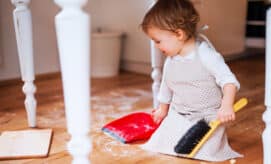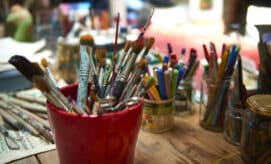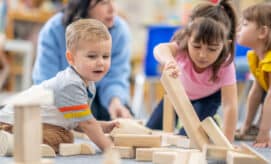Cleaning up is an important part of classroom routine. It represents respect and care for the shared space that you and the children spend so much time in together. When children are encouraged to be a part of the cleaning process, they also begin to take ownership and accountability for the materials they use during play.
Benefits
Having children clean up teaches important developmental skills such as sorting and organization. Kylie D’Alton (author of the book Kids in the Kitchen: Simple Recipes that Build Independence and Confidence the Montessori Way and creator of the blog How We Montessori) explains that encouraging children to clean up and put materials away teaches natural consequences and responsibility. “If we pick up our toys our spaces are in order, we have clean work and play areas, and we can find our things. Not picking up also teaches natural consequences; if we don’t pick up, the place is a mess and there is no clear space.”
Additionally, making cleaning a part of the daily routine can help children learn self control and positive behavior. Zero to Three states that “everyday actions are rich opportunities to support…learning and development while having fun. Routines offer the chance to build self-confidence, curiosity, social skills, self-control, communication skills, and more.”
How to Encourage Children
How We Montessori recommends the following to help encourage children to be a part of the clean-up process:
-
Break Down the Task: “If the child is overwhelmed, help them with clean up. This is especially important with older children, 3 years and on, when their mess might be more complex. Show them where to start, ‘perhaps we will pick up the blankets first, then we can put the cars in this basket’ or ‘can you pick up the cars and I will pick up the dolls?’”
Developmentally Appropriate Expectations
While it is important for young children to participate in clean-up, our expectations must be in line with a child’s capability. Cristina Moreno, a parent and Bilingual Outreach Specialist of Penfield Children’s Center (an early childhood center in Milwaukee serving children with and without developmental delays or disabilities by providing early education, health services and family programming) explains that “Age-appropriate expectations are important to avoid frustration and hurt feelings from both parties. Having too high expectations for a child’s developmental stage sets him up for situations where he will not be able to succeed, and his emotional growth and self-esteem can suffer.”
So what is right for each age?
For Toddlers
-
Toddlers have a hard time understanding cause and effect, so it might be difficult for them to connect how their own actions contribute to the mess of the space. However, toddlers do love to be helpers! Try presenting clean-up as a fun transitional activity, rather than a chore that has to be completed.
-
Demonstrate what you want toddlers to do by showing them how to put their materials back in the basket or on the shelves. Older toddlers might even be comfortable putting their plate in a dish bin after mealtimes, with the support of an adult.
-
Provide lots of positive reinforcement when the clean-up is complete.
-
Much of toddlerhood is about exploration of daily routines. It is fun for them when you offer them small brooms to help sweep the floor and spray bottles with rags to wipe down tables. The process of cleaning up helps toddlers learn important skills that will enable them to contribute to the cleanup routine more successfully as they get older.
-
Multi-step instructions can be overwhelming for toddlers. Try to remember to use simple requests, rather than expecting them to process lots of words and instructions at one time.
For Preschool & Pre-K






